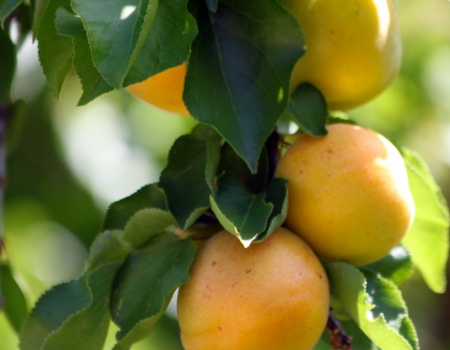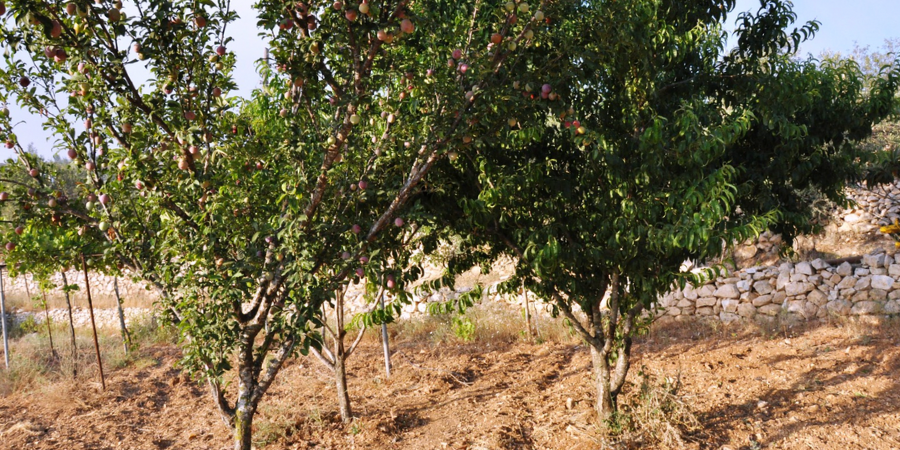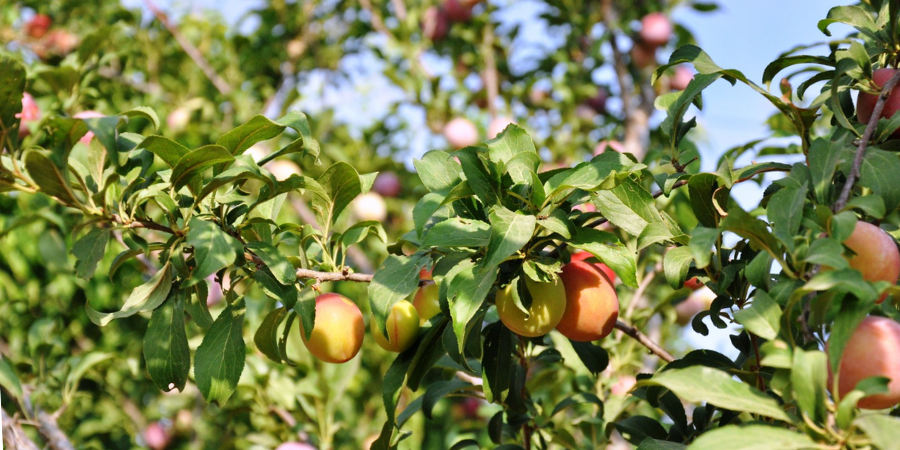Apricot Trees: Care, Growth and More!

Apricot trees have a spreading habitat and small size, with ovate leaves with pointed tips. The tree's leaves are bright green, while the white flowers self-pollinate. Although an apricot tree takes a few years to bear fruit, you can enjoy beautiful blooms and delicious fruit once your tree matures. Growing an apricot tree is relatively easier than other fruits. Let's learn how to perfect it.
Fast Facts for the Apricot Trees
| Common Name | Apricot tree, Ansu apricot, Siberian apricot, Armenian plum |
|---|---|
| Scientific Name | Prunus armeniaca |
| Harvest | June through August, but may differ across varieties |
| Light | Require at least six to eight hours of daily sunlight |
| Water | Need to be watered once every two weeks or 10 days |
| Soil | Thrive in fertile and well-draining soil that retains moisture; the pH should be acidic to neutral |
| Fertilizer | Need to be fertilized with a nitrogen-rich fertilizer once the tree starts bearing fruit |
| Pests | Susceptible to attack by borers, tortrix moths, oriental fruit moths, wood boring beetle, and aphids |
| Diseases | Can get affected by powdery mildew, bacterial canker, and brown rot |
| Growing Zone | 4 to 9 |
Table of Contents

Everything You Need to Know to Take Care of The Apricot Tree
The apricot tree grows anywhere from 26 to 36 feet and has a trunk diameter of 16 inches. Its branches have a spreading canopy with pointed leaves that range in size from 1 to 3 inches.
Apricot trees need to grow in a vegetative state for a few years. After that, they begin flowering in early spring. These flowers are small, self-pollinating, and may be pink or white. They have five petals.
After self-pollinating, the flowers die, while their cores stay on the tree to form stone fruits. The apricot fruit may be pink or orange with velvety skin. If you want to grow your own home orchard for fresh apricots, follow the care tips below.
Planting
While you can produce an apricot tree from the stone of the apricot fruit, it's easier to grow a plant with a grafted tree or seedling. You can simply get your preferred variety from a local nursery.
After that, select a place in your yard with well-drained soil and sufficient sun exposure. It's best to plant apricot trees in late winter since the plant is dormant during this time. Alternatively, you can plant fruit trees in early spring.
Initially, you can start with one tree and grow more as your first one starts fruiting. But if you want to plant multiple apricot trees at once, keep a distance of 20 feet between each fruit tree.
For a grafted tree, ensure your plant's position is north-facing, away from harsh sunlight. Here's how to plant a grafted tree:
- Make a hole in your garden that can fit the root ball of the tree. In the center, make a soil cone to allow downward and outward root spreading.
- Plant the grafted tree into the hole.
- Put the soil in and water the area. Push the earth with your hands or the back of a rake to ensure the soil is tightly packed around the roots.
After you've planted the tree, make a berm around it. The berm will help water to penetrate up to the roots. Put a layer of mulch and compost on this area, but make sure the mulch does not touch the tree trunk.
If you live in an area with strong winds, use stakes to keep the apricot tree upright. Install two stakes a few inches from the tree trunk and tie up the apricot tree.
The method mentioned above works well for most apricot varieties. Some dwarf varieties can also be planted in containers. Use a clay planter with a width of 20 inches. It should be a few feet deep.
Care and Maintenance
Caring for an apricot tree involves fertilizing it in a timely manner and meetings its water, soil, humidity, and temperature needs. Follow these maintenance tips to grow apricot trees.
Sun and Temperature
Apricot trees require about 6 to 8 hours of sunlight every day to thrive. Although most varieties grow in warm weather, some are also cold-hardy. Ideally, the temperature should be 65 to 85 degrees Fahrenheit for an apricot tree to stay healthy.
Young trees might not be as resilient, but mature apricot trees can withstand sudden cold snaps. Younger trees will die if the temperature reaches the freezing point.
Water and Humidity
On average, an apricot tree should get 1 inch of water per week. You can create a watering schedule accordingly. In the growth period, the top few inches of the soil must be moist at all times.
If you're forgetful about watering your plants, invest in a drip irrigation system. In summer, the plant should be watered once a week. During dormancy, water every other week.
Apricot trees do not need to be watered in rainy seasons. However, increase the frequency of watering during fruiting and flowering periods.
Soil
A well-draining soil is the main requirement for apricot trees. Opt for loamy and fertile soils with a pH range from 6.5 to 8.
Although there's no specific soil type needed, soil with poor nutrition will hinder tree growth and fruit production. Soil amendments like compost and manure can help.
Fertilizing
Apricot trees only require fertilizing in late summer and when winter ends. Do not fertilize apricot trees during the first few years of growth. After two years, you can start fertilizing them for good foliage growth.
In the fourth year of growth, apply a nitrogen-rich fertilizer with a high phosphorus content. A powder fruit tree fertilizer will work well for apricot trees. Use one cup of fertilizer for every inch of the tree's diameter.
Pruning
Pruning the apricot tree can help give it shape and structure. The right time to prune is in winter or late fall. Here's what to do:
- Prune damaged and broken branches to allow air circulation.
- Remove any branches growing toward the tree trunk.
- Remove some branches from the canopy if the top layer is too dense and isn't allowing sunlight to reach the bottom layer.
- Prune older branches that do not produce fruit anymore.
If you see branches bundled together, remove the thinner or damaged ones to ensure the healthy branches don't have to compete with them for resources.
Propagation
There are three ways to propagate an apricot tree.
- Grafting
- Cutting
- Seedling
We have already discussed how to grow an apricot tree with a graft. Here's how to do the same with a seed:
- After the fruiting period, the trees drop any apricots that were not attended.
- Take the pit of an apricot fruit.
- Fill a planter with well-drained and loamy soil.
- Put the pit in the soil and place the planter in sunlight.
Similarly, if you need to grow apricot trees with cuttings, you must take a healthy cutting from the branch. The cutting should be about 9 inches in length.
Take the leaves off the cutting and put the branch in the rooting hormone. Again, fill a clay planter with fertile soil and plant the cutting in it.
Harvesting and Storing
Like most fruit trees, apricot trees also produce fruit during early spring. The fruit on the tree will be red or yellow in color, indicating it's time to harvest.
Harvesting
It's quite simple to harvest fresh fruit. You can use your hand to pick apricots from the tree. A pole can help you get fruit off the higher-up branches.
If you see any fruit with unusual white spots, remove them to let the tree thrive without having to waste its resources on unhealthy fruits. You can eat the fruit right off the branches. Just wash it beforehand.
Storing
You can eat the juicy fruit immediately or store it in the fridge for up to three weeks. Do not put apricots with an ethylene-emitting vegetable in your fridge since that will make the fruit go bad.
For year-long storage, put the fruit in an airtight bag in your freezer. Some people also store dried apricots for use in baking. These apricots remain fresh for about six months in airtight containers.
Canned apricots that you get from the store can last for two years. If you decide to make jam with homegrown fruit, you can use it for up to 12 months. Whichever storage method you use, always make sure to keep the fruit in airtight packages.
Did you know? An apricot tree can keep producing fruit for about 25 years.
Common Issues With Apricot Trees

Apricots don't really have many growing problems, but they are susceptible to several diseases and pest infestations. We discuss them below.
Growing Problems
The main growing problem for apricot trees is late frosts. If you do not protect unestablished trees from frost with a frost cloth or blanket, the cold temperature can kill the tree.
Like extreme cold, too much heat is not good for apricot trees. The trees require adequate sunlight, but they should not be grown in harsh light. Otherwise, the extreme heat can stunt pollination and cause flowers to drop off the tree.
You can remediate this problem by providing an umbrella for your apricot tree. Also, water your tree more in hot periods to keep it hydrated. If it's the flowering period, but your tree is showing no signs of bloom, you'll need to fertilize it.
As already mentioned, unattended apricot fruits drop from the tree on the ground. The pits of these fruits germinate over time, producing leaves. That's not a good thing since these germinated pits will compete with the tree for sunlight and soil nutrition.
You should remove all fallen pits and fruits from the ground to avoid this problem.
Pests
When you grow apricot trees, you should be familiar with their pests and how to deal with them.
Crown Borers
The twig borer or crown borer is an insect that infests the twigs and root crowns of fruit trees. These pests eat up the tree trunk's base and also damage the twigs of apricot trees.
If you notice these pests, the best time to eliminate them is after the tree flowers. Apply a pyrethrin or spinosad spray every week to keep crown borers at bay.
Aphids
Aphids affect many trees, including apricot trees. They are 1/16 to 1/18 inches in length and soft-bodied. They are shaped like pears and can be colored brown, red, green, gray, or black. Mature aphids may or may not have wings. Winged pests are slightly darker than wingless aphids.
Aphids have a needle-like mouth that they use to suck the plant's sap. They can feed on twigs, roots, bark, underside of leaves, and unopened flower buds. Some symptoms of aphid feeding include:
- Poor growth
- Stunted shoots
- Dead shoots
- Yellow foliage
- Curled or twisted leaves
One way to manage aphids physically is by knocking them off the tree with a strong water jet. The stream of water will also remove mold and honeydew from the plant.
Some natural predators of aphids are lady beetles, lacewings, parasitic wasps, and syrphid fly larvae. They feed on aphids to reduce their number in your apricot orchard.
Earwigs
Earwigs affect apricot trees during summer, chewing holes in the flower blooms and leaves. These pests are 5/8-inch long and have a reddish-brown body. Like aphids, they also have chewing mouthparts.
Larger and well-established apricot trees can tolerate an earwig infestation, but younger trees cannot. If the infestation is large enough, it can damage the flowering plant. It can also kill the seedlings in the early stages.
You can prevent an earwig infestation by:
- Removing or thinning out mulch from around the tree
- Cleaning up the debris in your garden that can provide a hiding spot for earwigs, such as plant debris, lumber, bricks, and leaves
- Removing excess moisture from the garden
- Ensuring proper drainage in your landscape
- Sealing off any entry points, such as cracks in your fence, from where earwigs can enter your home
Alternatively, you can use the following pesticides to remove earwigs:
- Permethrin
- Acetamiprid
- Carbaryl
- Deltamethrin
Some arborists also recommend using deltamethrin dust.
Diseases
Like pests, apricot trees are also affected by several diseases. Here are some of them.
Shothole
Wilsonomyces carpophilus is a fungus that causes Shothole on apricot trees. It is characterized by small, circular spots on the leaves of the tree. The fungus affects the flower buds, leaves, and new shoots. If you do not treat the condition in the early stages, it can spread to the young fruits and result in lesions.
You should treat the shothole when the tree is dormant. Apply a Bordeaux mix or copper-containing fungicidal spray to the plant. Apricot trees should not be sprayed with sulfur fungicides.
Proper treatment during winter can help reduce the likelihood of shothole. If the problem still persists, remove the affected branches before the fungus spreads to other limbs.
Bacterial Canker
Bacterial or perennial canker is characterized by black or brown lesions on the bark of the tree. You can avoid its incidence and spread through good cultural practices. For example, sanitize your pruning tools. Also, keep your tree safe from sunscald in the winter using a white tree wrap.
Powdery Mildew
If you notice powdery spots, white to gray in color, on the leaves, buds, and stems of your tree, they're likely due to powdery mildew. Infected leaves are also twisted and could turn yellow in severe infections.
You can prevent powdery mildew by preventing overcrowding between trees. Keep recommended space between adjacent apricot trees. Use the following chemical treatments, if required:
- Thiophanate methyl
- Chlorothalonil
- Potassium bicarbonate
Always check the fungicide label for safety and usage instructions before applying.
Brown Rot
Brown rot is another fungal disease that affects cherries, plums, pears, apples, and other fruits. Common symptoms of brown rot include:
- Fungal pustules on the fruit surface
- Affected fruit falling from the tree or being mummified on the tree
- Wilting leaves and blossoms during blooming periods
Although there are no recommended chemical controls for brown rot, you can take the non-chemical route. Prune any infected blossoms and spurs before the fungus has the chance to read. Also, try to keep your tree safe from bird-inflicted damage since brown rot enters the trees through bird-caused wounds.
FAQs
Before you go...
Now that you know how to take care of apricot trees, you might be interested in some other plant care guides. Be sure to check out our other guide on the pluot tree so you can learn more about unique things to garden...
Related Articles:

Christina Hernandez
Christina has done most of her research on environmental science but recently has changed her focus towards sustainable forestry. She has a passion for the outdoors and wants to spread that passion to the world.
Join our community!
Join to receive guides, insights, and the latest gardening deals!
